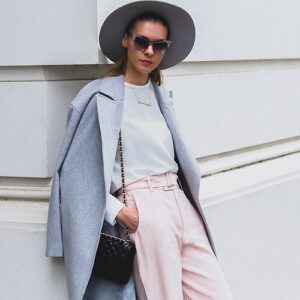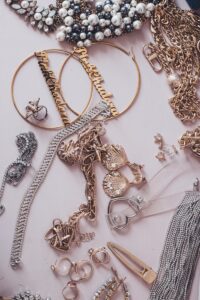Mastering how to style a monochrome outfit can elevate your fashion game significantly. Whether you’re aiming for a sleek, all-black ensemble or a bold, all-red statement, the key lies in mixing textures, layering pieces, and accessorizing wisely. Let’s dive into the nuances that can help you pull off this chic, minimalist style with confidence.
When I first dabbled in the world of fashion, the idea of styling a monochrome outfit seemed both intriguing and a bit daunting. The concept is deceptively simple: dress in a single color palette, yet the execution requires a keen eye for detail and balance. It’s not just about choosing items of the same color; it’s about creating a cohesive look that’s both stylish and sophisticated.
Understanding Monochrome Fashion
Monochrome fashion involves dressing in a single color or shades of the same color family, leading to a cohesive and visually striking appearance. This style focuses on simplicity and elegance, allowing for the seamless integration of different textures and layering techniques to enhance visual appeal.
Definition and History
Monochrome fashion, also known as monochromatic dressing, is the practice of wearing outfits composed entirely of garments and accessories within the same color or very similar shades of one color. The term “monochrome” itself is derived from the Greek words ‘monos’ meaning single and ‘chroma’ meaning color. Historically, monochrome looks have been prevalent in various forms of art and design, transitioning into fashion as a bold and minimalist statement. Designers from the early 20th century to present day have embraced monochrome to showcase purity of form and structural elements without the distraction of multiple colors. This technique has not only persisted but thrived, capturing the imagination of couturiers and street style fashionistas alike.
Reasons for Its Popularity
Monochrome fashion remains popular for several compelling reasons. Firstly, assembling a monochrome outfit simplifies the process of creating a look that’s both refined and impactful. Dressing head-to-toe in one color or its variations elongates the silhouette, creating a streamlined appearance that’s flattering on all body types. Additionally, this style allows for creative expression through the use of varying textures and complementary accessories to create depth and maintain interest in the outfit. Moreover, monochrome is versatile; it fits seamlessly into both casual and formal occasions. For a casual outing, a simple black dress might be accentuated with a denim jacket, while for a formal event, the same color scheme could be elevated with a silk gown and statement jewelry. This adaptability and ease of styling contribute significantly to the enduring appeal of monochrome looks.
How to Style a Monochrome Outfit
Styling a monochrome outfit involves a blend of simplicity and creativity, focusing on a single color palette to create an elegant and cohesive look. I’ll guide you through selecting the right color, mixing textures, and choosing the perfect accessories to enhance your monochromatic outfit.
Choosing the Right Color
Selecting the best color for a monochrome outfit is crucial, as it sets the mood and reflects your personal style. You’ll want to consider your skin tone and the setting or occasion. For cooler skin tones, colors like blue, green, and purple make excellent choices, while warmer tones are complemented by red, orange, and yellow hues. Neutral shades like black, white, and grey work universally and offer versatile styling options for different occasions. When you decide on a color, commit to varying shades within the same color family to create depth and interest.
Mixing Textures and Layers
The success of a monochrome look often lies in mixing different textures, which keeps the outfit from looking flat. I combine smooth fabrics like silk or satin with rougher textures such as wool or denim to add visual interest. For instance, a smooth black silk blouse paired with a black leather jacket and black denim jeans can transform a simple monochrome look into a striking ensemble. Layering also plays a significant role, with options like a chunky knit sweater over a fine cotton turtleneck or a structured blazer over a flowing dress. These combinations ensure that your monochrome outfit maintains a rich and dynamic appearance.
Importance of Accessories
Accessories are pivotal in elevating a monochrome outfit, providing that pop of luxury or an unexpected twist. I often use statement jewelry, such as bold earrings or a chunky necklace, to break the monotony and add sparkle. Belts, watches, and bags in matching hues or contrasting textures also enhance the outfit’s visual appeal. Don’t underestimate the power of shoes; a monochrome look paired with shoes in a matching hue or, alternatively, a contrasting color can make your outfit stand out. Even small details, like the metal finish on your accessories (gold, silver, or brass), can tie your whole look together and create a polished and sophisticated appearance.
Monochrome Outfit Ideas for Different Occasions
Monochrome outfits provide a streamlined silhouette that’s both elegant and versatile, proving perfect for various events. I’ll explore how to style these looks across casual settings, work environments, and special occasions, ensuring you achieve a balanced and stylish appearance every time.
Casual Wear
Casual monochrome looks offer comfort without sacrificing style. I often recommend starting with a base of soft, neutral colors like grey or beige for a laid-back look. Adding a denim jacket in a matching hue elevates a simple monochromatic t-shirt and jeans combo, injecting a bit of rugged texture. For footwear, white sneakers are a go-to choice, maintaining the color flow while providing practicality. If you’re venturing out for casual outings like a coffee date or a shopping trip, incorporating varied textures, such as a ribbed knit sweater or a suede bag, can enhance visual appeal and add depth to your outfit.
Work Attire
For a professional setting, choosing darker shades in the same color family presents a refined and powerful image. A navy or charcoal suit offers a traditional monochrome look that meets most office dress codes. I find mixing different textures within the same color to be effective for keeping the outfit interesting yet appropriate. A silk blouse under a wool blazer, for example, adds a touch of sophistication. Accessories play a key role in work attire; a pair of silver cufflinks or a sleek leather belt in a similar tone can tie the entire outfit together seamlessly. Always aim for a balance, ensuring your monochrome outfit is neat and not overly busy, which helps maintain a professional demeanor.
Special Events
When dressing for a special event, monochromatic fashion allows for bold statements through simplicity. Opting for vibrant hues like emerald green or royal blue can make a dramatic impact at any formal occasion. For women, a flowing monochrome gown paired with bold earrings and a clutch of the same shade delivers a captivating look. Men can achieve a standout appearance with a tailored monochrome suit, accessorized with a matching tie and pocket square to enhance the overall elegance. At these events, it’s beneficial to play with varying shades and luxurious materials such as velvet or satin to create depth and draw the eye, ensuring you look polished and distinctive.
Mistakes to Avoid in Monochrome Styling
Monochrome outfits offer a stylish and cohesive look when done right, but certain missteps can undermine the elegance of this fashion choice. As I guide readers through perfecting monochrome styling, I’ll highlight key errors to sidestep to ensure a chic, polished appearance. For those interested in exploring more timeless fashion advice, understanding the nuances of classic menswear brands can be a valuable complement to mastering monochrome looks.
Overlooking Texture Variation
Using different textures is crucial in monochromatic styling; it enhances visual appeal and prevents the outfit from appearing flat or monotonous. When crafting a monochrome look, I mix fabrics such as silk, denim, wool, or leather to create depth and interest within the same color family. For instance, for a casual outing, pairing a cotton t-shirt with a leather skirt in light grey can break up the monotony effectively. In addition to textures, understanding how to dress for specific events, such as weddings, can refine your overall fashion sense, ensuring that your monochrome choices are both appropriate and stylish.
Ignoring Fit and Silhouette
The right fit is vital in monochrome fashion as poor-fitting clothes can significantly detract from an otherwise streamlined silhouette. I ensure each piece fits well, and I balance oversized items with more tailored pieces to maintain a flattering proportion. For example, if I wear a loose-fitting sweater, I’ll pair it with skinny jeans or a fitted skirt to keep the overall look balanced. If you’re interested in how fit plays a role beyond monochrome outfits, consider learning how to look good at a pool party, where balancing fit and style is equally essential.
Choosing Incorrect Shades
Staying within the same color family doesn’t mean all shades will match perfectly. I pay close attention to the shades I choose to ensure they harmonize well. Avoiding clashing undertones is key; for instance, a warm beige top might not pair well with a cool beige pant. I prefer to layer varying shades of the same hue to add dimension and keep the outfit interesting. Understanding the importance of shade compatibility can be as crucial as selecting the right cargo pants for men, where color choices can make or break the outfit.
Forgetting to Accessorize
Accessories play a pivotal role in monochrome outfits, adding a layer of sophistication and personality. I incorporate statement jewelry, bold earrings, or a standout handbag to break up the uniformity and introduce an element of surprise. Matching hue accessories can elevate the monochromatic look significantly. Much like how you might approach mastering premium memorabilia acquisitions, where details and subtle choices matter, accessorizing in monochrome styling requires a keen eye for detail and taste.
Ensuring a successful monochrome outfit involves more than selecting clothes from the same color spectrum. I carefully consider texture variations, fit, shade compatibility, and the strategic use of accessories to craft an ensemble that’s both visually appealing and distinctly fashionable, suitable for different occasions and reflecting a personal style.
Styling a monochrome outfit is more than just picking items of the same color; it’s about mastering the art of subtlety and balance. I’ve shared how you can elevate your fashion game by focusing on textures, layers, and the right accessories. Whether you’re dressing for a casual day out, a formal event, or the workplace, these tips ensure you look effortlessly chic. Remember, the key is in the details. By applying these simple yet effective strategies, you’ll not only look good but also feel confident in your monochrome ensemble. Embrace the monochrome trend and make a statement with your style!
Frequently Asked Questions
What is monochrome fashion?
Monochrome fashion involves styling outfits using one color or varying shades of the same color. It emphasizes simplicity and elegance while allowing for creativity through textures and accessories.
Why choose monochrome styling?
Monochrome outfits offer a visually streamlined appearance that can elongate the silhouette, making you appear taller and more cohesive. They are versatile and suitable for multiple occasions, providing a sophisticated and elegant look.
How can you make monochrome outfits more interesting?
Enhance monochrome outfits by mixing textures (like combining silk with wool), introducing layers, and adding various shades or tones of the same color. Additionally, incorporate accessories like belts or statement jewelry to add depth and personality.
What are the best occasions for wearing monochrome?
Monochrome outfits are perfect for any setting, from casual gatherings and office environments to formal events. Their simplicity and elegance make them adaptable and appropriate across various social situations.
Can monochrome outfits vary in color shade?
Absolutely! Monochrome doesn’t mean a single tint; varying shades of the same color can be used to create depth, contrast, and visual interest within the outfit.
What should be considered when choosing accessories for monochrome outfits?
When accessorizing a monochrome outfit, consider choosing accessories that either complement or subtly contrast with the primary color. Metallics generally work well, or you can opt for a pop of a neutral color like white, black, or gray.
Are monochrome outfits only suitable for certain body types?
No, monochrome outfits are flattering on all body types. They can help elongate the body’s appearance and provide a clean, uninterrupted line. Choose the right fit and proportions to enhance your body type.
- How To Be Elegant And Sophisticated
- How To Bleach White Dress Shirts
- How To Break In Slip On Vans
- How To Brush A Beard
- How To Clean A Beard Brush
- How To Comb Your Moustache
- How To Compliment A Girls Outfit
- How To Dress More Feminine
- How To Dye A Moustache Tips Tricks And Techniques
- How To Get Beard Dye Off Skin
- How To Get Rid Of Stubble
- How To Keep A Bald Head Smooth Without Shaving
- How To Look Good At A Pool Party
- How To Look Put Together With Minimal Effort
- How To Loosen Tight Shoes At Home
- How To Make Your Perfume Last Longer
- How To Match Colors In Mens Fashion
- How To Measure For Hat Size For A Man
- How To Pack Ties For Moving
- How To Prepare To Wear Heels
- How To Put A Bow Tie On
- How To Read Mens Pants Size
- How To Remove Pleats From Pants
- How To Style A Monochrome Outfit
- How To Style Alexander McQueen Sneakers 10 Ways
- How To Thin Out Arm Hair For Guys
- How To Tie Dye A Black Shirt
- How To Train A Moustache The Ultimate Guide
- How To Train Your Hair To Slick Back Naturally
- How To Wear A Boutonniere
- How To Wear A Button Down Shirt Open
- How To Wear A Flat Cap
- How To Wear A Hat With A Bun
- How To Wear A Jumpsuit
- How To Wear A Pin On A Tie
- How To Wear A Spaghetti Strap Dress In The Winter
- How To Wear A Stole The Ultimate Guide
- How To Wear A Swing Dress In Winter
- How To Wear Chinos With Sneakers
- How To Wear Crew Socks 9 Creative Ways
- How To Wear Flats With A Formal Dress
- How To Wear Loafers With Jeans
- How To Wear White Lipstick



